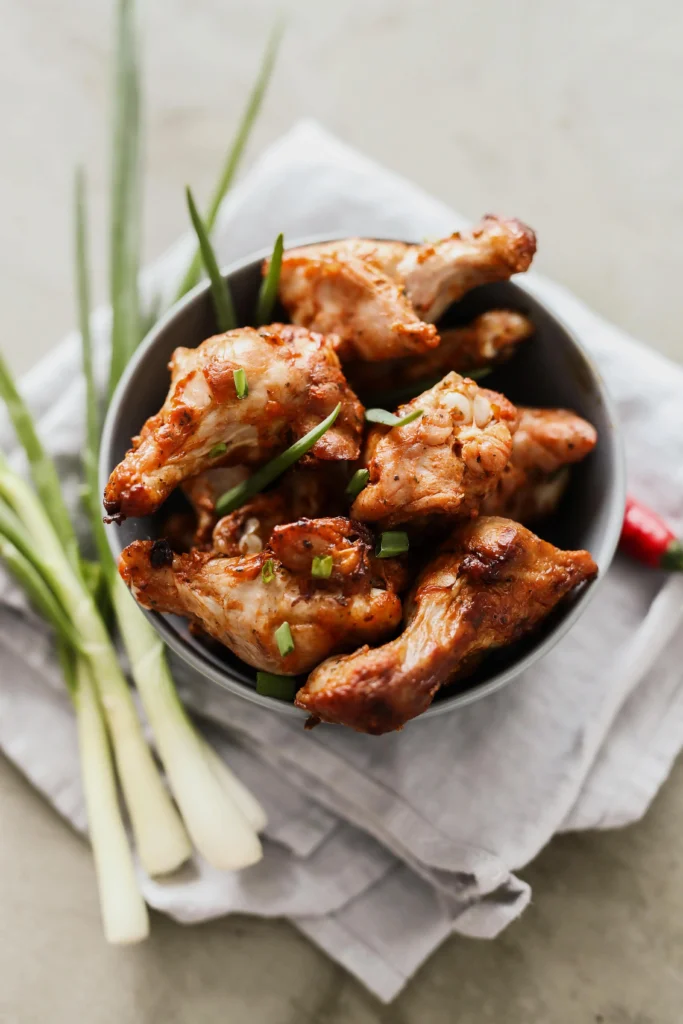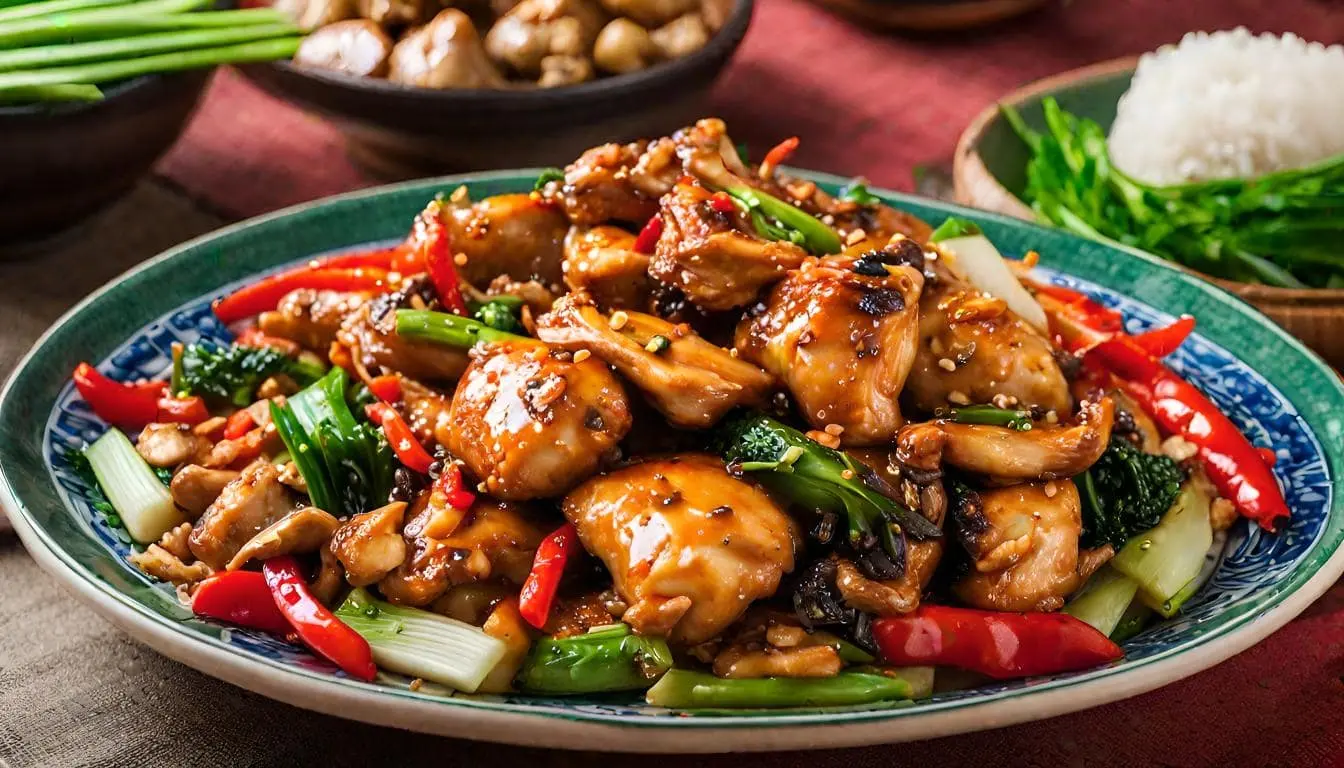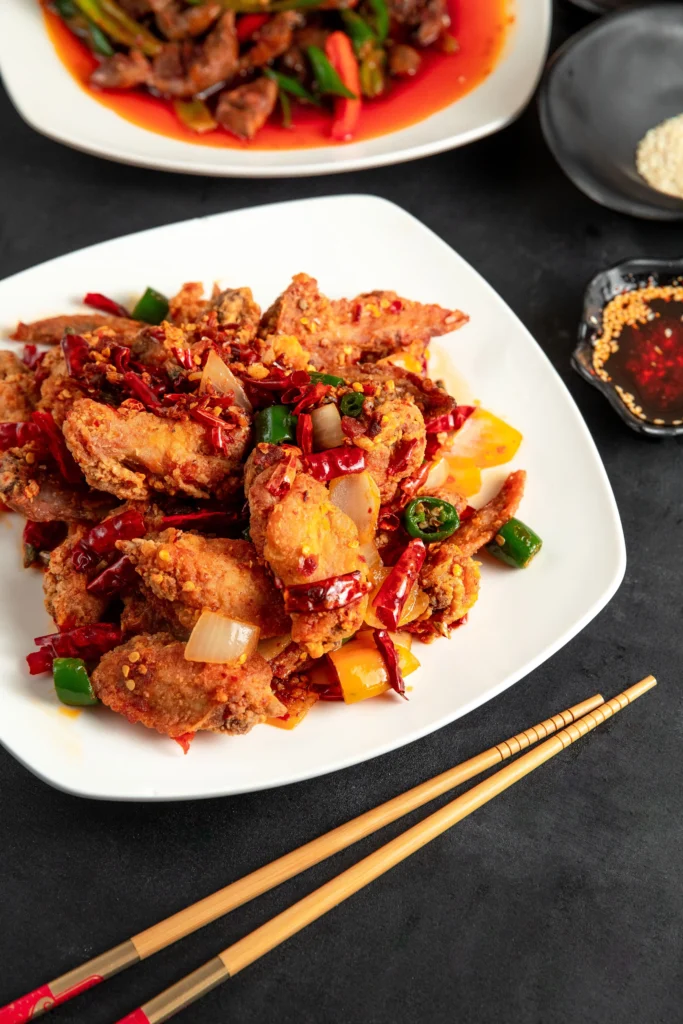Hong Sue Chicken
Overview of Hong Sue Chicken
Hong Sue Chicken stands as a testament to the diversity and richness of Chinese cuisine. Originating from the bustling kitchens of Guangdong province, this dish brings together the essential elements of Cantonese cooking: a harmonious balance of sweet, sour, and umami flavors. At its core, Hong Sue Chicken features succulent chicken pieces that are marinated and stir-fried to perfection, accompanied by a variety of aromatic vegetables and enriched with quintessential Chinese condiments like soy sauce and rice wine.
Origins and Cultural Significance
The story of Hong Sue Chicken is as intriguing as its taste. Believed to have originated in the early 20th century, possibly in San Francisco, this dish was likely a creative endeavor to cater to the American palate, blending traditional Chinese flavors with a less spicy profile. It reflects the adaptability and innovative spirit of Chinese-American cuisine, embodying a culinary bridge between Eastern and Western taste preferences.
Throughout its evolution, Hong Sue Chicken has remained a beloved fixture in both traditional Chinese households and Chinese-American restaurants. It’s not just a dish; it’s a cultural icon, representing the fusion of cultures and the enduring legacy of Chinese culinary traditions. As we dive deeper into the recipe, preparation, and variations of this dish, we’ll gain a greater appreciation for the art of Chinese cooking and the rich history embedded in every bite of Hong Sue Chicken.
Recipe and Preparation of Hong Sue Chicken
Ingredients for Hong Sue Chicken
Essential Ingredients and Substitutes
To create Hong Sue Chicken, start with chicken—either breast or thigh. These cuts absorb flavors well and provide a nice texture. Key vegetables include mushrooms, bok choy, and red peppers, each adding a unique touch. The flavor profile relies on Chinese condiments: soy sauce, oyster sauce, hoisin sauce, and sherry.
For dietary adjustments or ingredient availability, try substituting sherry with rice vinegar and hoisin sauce with a mix of soy sauce and honey. The flexibility of this dish allows incorporating various vegetables based on personal preference or seasonal availability.
Step-by-Step Cooking Instructions
Marinating, Cooking, and Final Touches
Marinate the chicken in a blend of soy sauce, hoisin sauce, sherry, garlic, and ginger. This process infuses flavor and tenderizes the meat. Stir-fry the marinated chicken until golden, releasing aromatic flavors.
Next, stir-fry the vegetables until tender yet crisp, balancing texture and flavor. The sauce, made from the same elements as the marinade, is then poured over the chicken and vegetables, simmering to a thick glaze.
Cooking Tips and Tricks
Techniques for Perfect Texture and Flavor
For an extra tender chicken, try the velveting technique, involving egg whites and cornstarch. It’s optional but adds a silky texture. Balance the soy sauce, sugar, and vinegar to achieve the right sweet, salty, and tangy flavor profile. Adjust ratios to taste.
In stir-frying, high heat and quick movements are essential. This method cooks the ingredients swiftly while preserving their texture and nutrition. Serve the dish over steamed rice or noodles and garnish with green onions or sesame seeds for added appeal.
Nutritional Breakdown of Hong Sue Chicken
Hong Sue Chicken, a savory and enticing dish, is not only a delight for the taste buds but also offers a range of nutritional benefits. The primary component, chicken, is an excellent source of lean protein, vital for muscle growth and repair. A typical serving of Hong Sue Chicken contains approximately 38g of protein, making it an ideal choice for those looking to maintain or increase their muscle mass.
Carbohydrates also play a role, primarily coming from the vegetables and sauce ingredients. A standard portion might contain around 26g of carbohydrates, providing the necessary energy for daily activities. The dish is relatively low in fat, with an average of 8g per serving, and includes beneficial unsaturated fats from ingredients like sesame oil. It’s also a good source of dietary fiber, courtesy of the vegetables, contributing to digestive health.
Health Benefits
Role in Diet and Wellness
Incorporating Hong Sue Chicken into your diet can offer multiple health benefits. Firstly, the high protein content from chicken aids in muscle maintenance and supports a healthy metabolism. The variety of vegetables used in the dish, such as mushrooms and bok choy, contribute essential vitamins and minerals. These nutrients are crucial for immune function, bone health, and overall wellness.
The garlic and ginger used in the dish are known for their anti-inflammatory and antioxidant properties, potentially reducing the risk of chronic diseases. The dish’s moderate calorie count, approximately 330 calories per serving, makes it a suitable option for those managing their weight, provided it’s consumed in moderation and as part of a balanced diet.
Hong Sue Chicken can also play a role in heart health. The use of lean protein and the absence of heavy, creamy sauces typically result in lower saturated fat and cholesterol levels compared to many other meat dishes. This makes it a heart-friendly option, especially when served with a side of whole grains or steamed vegetables.
In summary, Hong Sue Chicken is more than just a tasty meal; it’s a nutritionally balanced dish that can support various aspects of health. From muscle building and immune support to heart health and weight management, this dish offers a delicious way to nourish your body. Remember, though, the key to any healthy diet is variety and moderation.
Variations and Serving Suggestions
Variations of the Dish
Regional Twists and Alternative Ingredients
Hong Sue Chicken is a versatile dish, embracing various regional twists and alternative ingredients, making it adaptable to diverse palates and dietary needs.
Substituting the Protein
One of the simplest variations is to substitute the chicken with other proteins. Pork, beef, or shrimp can be excellent alternatives, offering different flavors and textures. For a vegetarian or vegan version, tofu or tempeh are great substitutes, absorbing the sauce’s flavors beautifully.
Playing with Vegetables
Vegetables in Hong Sue Chicken can be varied according to seasonal availability or personal preference. Popular choices include broccoli, snow peas, and bell peppers, each adding its unique color, texture, and nutrition. For a more distinct flavor, you could try adding spicy elements like chili peppers or sweet notes with pineapple chunks.
Adjusting the Sauce
The sauce is the heart of the dish, and tweaking it can transform the flavor profile completely. For a sweeter taste, adding a bit more brown sugar or honey works well. If you prefer a tangier sauce, increase the vinegar component. For those who enjoy a spicier kick, incorporating chili paste or hot sauce can add the necessary heat.
Incorporating Noodles or Rice
Hong Sue Chicken traditionally pairs well with steamed rice, but you can also serve it over noodles for a different experience. Whether it’s egg noodles for a richer taste or rice noodles for a lighter option, the dish adapts well to various bases.
Adding Nuts
For an extra crunch and a nutty flavor, consider adding cashews or peanuts. This not only enhances the texture but also adds healthy fats and proteins to the dish.
Fusion Twists
Embracing fusion cooking, you could incorporate elements from other cuisines. For example, adding a hint of Thai with lemongrass or basil can offer a refreshing twist. Similarly, incorporating a touch of Indian spices like garam masala can introduce an exotic flavor.
Regional Adaptations
In different parts of China and the world, Hong Sue Chicken takes on local flavors. In some regions, the dish might be spicier, while in others, it might have a sweeter note. This adaptability to local tastes is what makes Hong Sue Chicken a global favorite.
Explore a different regional chicken dish with our Spanish Chicken Wings recipe.
Serving Suggestions
Presentation and Accompaniments
Presentation plays a crucial role in enhancing the appeal of Hong Sue Chicken. Garnishing with green onions, sesame seeds, or fresh herbs can add color and freshness. Accompaniments like stir-fried vegetables, a simple green salad, or a side of dumplings can make the meal more wholesome and appealing.
Dietary Considerations
For those with dietary restrictions, it’s easy to modify Hong Sue Chicken to fit gluten-free, low-carb, or low-sodium diets. Using tamari sauce instead of soy sauce can make it gluten-free, while reducing the sugar or opting for low-sodium soy sauce can cater to other dietary needs.

Complementary Chinese Dishes
Creating a Complete Chinese Meal
When serving Hong Sue Chicken, pairing it with complementary Chinese dishes can turn a simple meal into an elaborate feast, capturing the essence of a traditional Chinese dining experience.
Starters and Appetizers
Begin your meal with light and refreshing appetizers. Options like spring rolls, packed with vegetables and perhaps some shrimp or pork, offer a delightful crunch and are perfect for whetting the appetite. Dim sum selections, such as steamed dumplings filled with pork or vegetables, are another excellent choice, embodying the flavors and techniques of Chinese culinary art.
Soup Course
A soup course is a staple in a Chinese meal, serving as a palate cleanser and a way to introduce more subtle flavors. A clear broth, like a simple egg drop soup or a more complex wonton soup, can be both comforting and light, setting the stage for the main course.
Main Course Combinations
Alongside Hong Sue Chicken, serve dishes that offer contrasting flavors and textures. A dish like Beef and Broccoli provides a savory and hearty counterpart, while a lighter, vegetable-centric dish such as Stir-Fried Snow Peas or Garlic Spinach adds freshness and balance. To incorporate seafood, consider adding Shrimp with Lobster Sauce, offering a luxurious and flavorful touch.
Side Dishes
Rice and noodles are essential sides in Chinese cuisine. Steamed jasmine or brown rice are great for soaking up the sauces, while Lo Mein or Chow Mein noodles can add a hearty and satisfying element to the meal.
Dessert
Conclude the meal with a light and simple dessert. Traditional options like sweet red bean soup or mango pudding provide a sweet end without being overly heavy. Alternatively, fresh fruit, such as lychee or longan, can be a refreshing and healthy way to complete the dining experience.
Beverage Pairings
For beverages, green or jasmine tea is a classic choice, offering a subtle flavor that complements the meal without overpowering it. For those who prefer something stronger, a rice wine like Shaoxing or a light beer can pair nicely with the varied flavors of Chinese cuisine.
Frequently Asked Questions
Q1: Can I make Hong Sue Chicken gluten-free?
A: Yes, you can easily make it by substituting regular soy sauce with a gluten-free alternative like tamari. Ensure that all other ingredients, such as hoisin sauce, are also gluten-free.
Q2: What are the best side dishes to serve with Hong Sue Chicken?
A: Steamed jasmine or brown rice are classic sides that complement the flavors of Hong Sue Chicken well. For a more varied meal, consider adding stir-fried vegetables, such as bok choy or broccoli, or serving it with Chow Mein or Lo Mein noodles.
Q3: Is Hong Sue Chicken suitable for a low-carb diet?
A: Hong Sue Chicken can be adapted for a low-carb diet by reducing or omitting sugar in the sauce and serving it with a low-carb side like cauliflower rice instead of traditional rice or noodles.
Q4: Can I use a different protein instead of chicken?
A: Absolutely! Pork, beef, shrimp, or tofu are great substitutes for chicken in this dish. Each alternative protein can offer a unique flavor and texture to the dish.
Q5: How can I make my Hong Sue Chicken spicier?
A: To add more heat to your Hong Sue Chicken, you can increase the amount of crushed red pepper flakes in the marinade or add a bit of chili paste or hot sauce to the sauce.
Q6: How long can I store leftovers, and how should I reheat them?
A: Leftover Hong Sue Chicken can be stored in the refrigerator for up to 3 days. For reheating, gently warm it in a microwave or on the stovetop over medium heat, adding a little water or chicken broth if the sauce has thickened.
Q7: Are there any health benefits to eating Hong Sue Chicken?
A: Yes, Hong Sue Chicken is rich in protein from the chicken and offers a variety of nutrients from the vegetables. It can be part of a balanced diet, especially when cooked with less oil and served with whole grains or additional vegetables.
Learn about the health benefits of a chicken-based diet in our article on the Carnivore Diet with Chicken.
Conclusion
Exploring Hong Sue Chicken has been an enlightening journey into Chinese cuisine. This dish, rich in history and flavor, showcases the diversity and adaptability of Chinese cooking. We’ve discovered its nutritional value and learned how to tailor it to various tastes and dietary needs.
Hong Sue Chicken is more than a recipe – it’s a celebration of cultural heritage. It offers a canvas for culinary creativity, inviting cooks of all levels to experiment and personalize. The dish is a perfect example of Chinese-American cuisine’s richness and versatility.
In cooking Hong Sue Chicken, let your creativity shine. Experiment with ingredients, cooking techniques, and presentation styles. Each variation you create is not only a delicious meal but also a tribute to the vibrant legacy of Chinese cooking.


